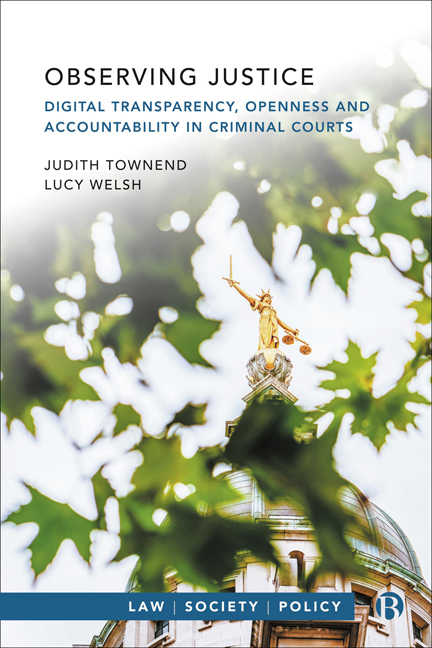Book contents
- Frontmatter
- Contents
- Series Editor’s Preface
- About the Authors
- Acknowledgements
- ONE Introduction: Why We Need to Rethink Approaches to Open Justice in the Criminal Courts
- TWO A History of Accountability in Criminal Courts
- THREE Justice System Modernisation, Digitalisation and Data
- FOUR The Role of the Public and Media in Observing Justice
- FIVE The Human Impact of Justice System Transparency
- SIX Conclusion: Towards a New Framework for Justice System Accountability
- References
- Index
THREE - Justice System Modernisation, Digitalisation and Data
Published online by Cambridge University Press: 28 March 2024
- Frontmatter
- Contents
- Series Editor’s Preface
- About the Authors
- Acknowledgements
- ONE Introduction: Why We Need to Rethink Approaches to Open Justice in the Criminal Courts
- TWO A History of Accountability in Criminal Courts
- THREE Justice System Modernisation, Digitalisation and Data
- FOUR The Role of the Public and Media in Observing Justice
- FIVE The Human Impact of Justice System Transparency
- SIX Conclusion: Towards a New Framework for Justice System Accountability
- References
- Index
Summary
Introduction
This chapter provides a descriptive analysis of 21st century criminal justice remodelling, including the ways in which digital technology has been adopted in the English and Welsh justice system, and some of the ramifications for digital data dissemination and publication. We will draw out connections between digitalisation and the principle of open justice as the chapter progresses. We focus on aspects of HM Courts and Tribunals Service (HMCTS)’s much criticised and delayed £1.3bn programme of modernisation and digital reform commenced in 2016 (HMCTS 2023c; Public Accounts Committee 2023). These include: the Single Justice Procedure (SJP) for the prosecution of minor offences, video-enabled justice (VEJ), aka virtual, or remote, courts in which some or all participants engage in hearings remotely, as well as digitalisation of data processes. We discuss the ways in which the COVID-19 pandemic has accelerated the use of remote hearings in criminal justice, and the continuation of these methods.
We consider the implications of these changes for traditional approaches to criminal justice system accountability, and open justice, in particular. To what extent do digital court processes enable participants and the public to engage in the justice system and hold it to account? How, for example, is information about an entirely administrative or virtual process communicated to the public? This chapter also considers the digital context outside the court room: how is justice system data being collected, processed and disseminated online, by different public and private sector actors?
In this chapter, we also look at equality of access to digital justice systems, in terms of funding, technological and legal literacy, as well as access to tools. In this context, we discuss power relationships and how technology is changing the dynamic and interactions of the digital and physical court room, making participation and engagement more difficult and undermining system accountability.
Single Justice Procedure
We begin our review of major reforms to summary criminal justice and open justice with the Single Justice Procedure (SJP). As a result of Part 3, Criminal Justice and Courts Act 2015, adults charged with summary only non-imprisonable offences may have their case dealt with in writing without ever attending court. The SJP allows people to enter pleas in writing or online. If the person pleads guilty using the SJP, the case is considered in camera by a single magistrate and legal adviser, but without either prosecuting or defending lawyers attending court.
- Type
- Chapter
- Information
- Observing JusticeDigital Transparency, Openness and Accountability in Criminal Courts, pp. 40 - 64Publisher: Bristol University PressPrint publication year: 2023

